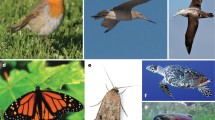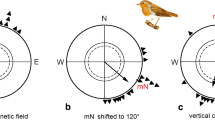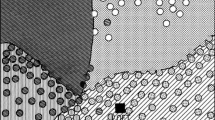Abstract
Experiments with migrating birds displaced during autumn migration outside their normal migration corridor reveal two different navigational strategies: adult migrants compensate for the displacement, and head towards their traditional wintering areas, whereas young first-time migrants continue in their migratory direction. Young birds are guided to their still unknown goal by a genetically coded migration program that indicates duration and direction(s) of the migratory flight by controlling the amount of migratory restlessness and the compass course(s) with respect to the geomagnetic field and celestial rotation. Adult migrants that have already wintered and are familiar with the goal area approach the goal by true navigation, specifically heading towards it and changing their course correspondingly after displacement. During their first journey, young birds experience the distribution of potential navigational factors en route and in their winter home, which allows them to truly navigate on their next migrations. The navigational factors used appear to include magnetic intensity as a component in their multi-modal navigational ‘map’; olfactory input is also involved, even if it is not yet entirely clear in what way. The mechanisms of migratory birds for true navigation over long distances appear to be in principle similar to those discussed for by homing pigeons.

Similar content being viewed by others
References
Able KP, Able MA (1990a) Ontogeny of migratory orientation in the savannah sparrow, Passerulus sanswichensis: calibration of the magnetic compass. Anim Behav 39:903–913
Able KP, Able MA (1990b) Calibration of the magnetic compass of a migratory birds by celestial rotation. Nature 347:378–380
Alerstam T (1987) Bird migration across a strong magnetic anomaly. J Exp Biol 130:63–86
Baccetti N, Serra L, Cherubini G, Magnani A (1999) Zeitpunkt der Festlegung von Bindungen an das Winterquartier nach Ergebnissen von Verfrachtungsexperimenten an Alpenstrandläufern (Calidris alpina). J Ornithol 140:309–317
Baillon F, Benvenuti S, Ioalè P (1992) Fidelity to non-breeding sites in some species of birds in Senegal. Trop Zool 5:31–43
Baker RR (1993) The function of post-fledging exploration: a pilot study of three species of passerines ringed in Britain. Ornis Scand 24:71–79
Beason RC, Wiltschko W (2015) Cues indicating location in pigeon navigation. J Comp Physiol A 201:961–967
Beason RC, Dussourd N, Deutschlander M (1995) Behavioral evidence for the use of magnetic material in magnetoreception by a migratory bird. J Exp Biol 198:141–146
Beck W, Wiltschko W (1982) The magnetic field as a reference system for the generically encoded migratory direction in pied flycatchers (Ficedula hypoleuca PALLAS). Z Tierpsychol 60:41–46
Benvenuti S, Fiaschi V (1983) Pigeon homing: combined effect of olfactory deprivation and visual impairment. Comp Biochem Physiol 76 A:719–725
Berthold P (1973) Relationships between migratory restlessness and migration distance in six Sylvia species. Ibis 115:594–599
Berthold P (1985) Vergleichende Untersuchung von Jugendentwicklung und Zugverhalten bei Garten- und Hausrotschwanz, Phoenicurus phoenicurus und P. ochurus. J Ornithol 126:383–392
Berthold P (1988) The control of migration in European warblers. Acta XIX Congr Internat Ornithol, Ottawa, pp 215–249
Berthold P, Querner U (1981) Genetic basis of migratory behavior in European warblers. Science 212:77–79
Bingman VP (1983) Magnetic field orientation of migratory savannah sparrows with different first summer experience. Behaviour 87:43–55
Bingman VP (1984) Night sky orientation of migratory pied flycatchers raised in different magnetic fields. Behav Ecol Sociobiol 15:77–80
Bletz H, Weindler P, Wiltschko R, Wiltschko W, Berthold P (1996) The magnetic field as reference for the innate migratory direction in blackcaps, Sylvia atricapilla. Naturwissenschaften 83:430–432
Bulte M, Bairlein F (2013) Endogenous control of migratory behavior in Alaskan northern wheatear. J Ornithol 154:567–570
Chernetsov N, Kishkinev D, Gashko, S, Kosarrev V, Bolshakov CV (2008a) Migratory programme of juvenile pied flycatchers, Ficedula hypoleuca, from Siberia implies a detour around Central Asia. Anim Behav 75:539–545
Chernetsov N, Kishkinev D, Mouritsen H (2008b) A long-distance avian migrant compensates for longitudinal displacement during spring migration. Curr Biol 18:188–190
Curry-Lindahl K (1982) Vogelzug. Paul Parey, Berlin Hamburg
Delmore KE, Irwin DE (2014) Hybrid songbirds employ intermediate routes in a migratory divide. Ecol Lett 17:1211–1218
Dennis TE, Rayner MJ, Walker MM (2007) Evidence that pigeons orient to geomagnetic intensity during homing. Proc R Soc B 274:1153–1158
Deutschlander ME, Phillips JB, Munro U (2012) Age-dependent orientation of magnetically-simulated geographic displacements in migratory Australian silvereyes (Zosterops l. lateralis). Wilson. J Ornithol 124:467–477
Dorst J (1961) The migration of birds. Heinemann, Toronto
Drost R (1938) Über den Einfluß von Verfrachtungen zur Herbstzugzeit auf den Sperber, Accipiter nisus (L.). Zugleich ein Beitrag zur Frage nach der Orientierung der Vögel auf dem Zug ins Winterquartier. IX Congrès Ornithol. Internat, Rouen, pp. 503–521
Emlen ST (1970) Celestial rotation: its importance in the development of migratory orientation. Science 170:1198–1201
Gagliardo A (2013) Forty years of olfactory navigation in birds. J Exp Biol 216:2165–2171
Gagliardo A, Ioalè P, Savini M, Wild M (2009) Navigational abilities of adult and experienced homing pigeons deprived of olfactory or trigeminally mediated magnetic information. J Exp Biol 212:3119–3124
Gwinner E (1968) Artspezifische Muster der Zugunruhe bei Laubsängern und ihre mögliche Bedeutung für die Beendigung des Zuges im Winterquartier. Z Tierpsychol 25:843–853
Gwinner E, Wiltschko W (1978) Endogenously controlled changes in the migratory direction of the garden warbler, Sylvia borin. J Comp Physiol 125:267–273
Gwinner E, Schwabl H, Schwabl-Benzinger I (1992) The migratory time program of the Garden Warbler: is there compensation for interruptions? Ornis Scand 23:264–270
Hartwick RF, Foà A, Papi F (1977) The effect of olfactory deprivation by nasal tubes upon homing behavior in pigeons. Behav Ecol Sociobiol 2:81–89
Helbig AJ (1991) Inheritance of the migratory direction in a bird species: a cross-breeding experiment with SE- and SW-migrating blackcaps (Sylvia atricapilla). Behav Ecol Sociobiol 28:9–12
Helbig AJ (1992) Ontogenetic stability of inherited migratory directions in a nocturnal bird migrant: comparison between the first and second year of life. Ethol Ecol Evol 4:375–388
Helbig AJ, Berthold P, Wiltschko W (1989) Migratory orientation of blackcaps (Sylvia atricapilla): population-specific shifts of direction during the autumn. Ethology 82:307–315
Henshaw I, Fransson T, Jakobsson, Kullberg C (2010) Geomagnetic field affects spring migratory direction in a long distance migrant. Behav Ecol Sociobiol 64:1317–1323
Holland RA (2010) Differential effects of magnetic pulses on the orientation of naturally migrating birds. J R Soc Interface 7:1617–1625
Holland RA, Helm B (2013) A strong magnetic pulse affects the precision of departure directions of naturally migrating adult but not juvenile bird. J R Soc Interface 10:20121047
Holland RA, Thorup K, Gagliardo A, Bisson IA, Knecht E, Mizrahi D, Wikelski M (2009) Testing the role of sensory systems in the migratory heading of a songbird. J Exp Biol 212:4065–4071
Jorge PE, Marques AE, Phillips JB (2009) Activational rather than navigational effects of odors on homing of young pigeons. Curr Biol 19:650–654
Jorge PE, Marques PAM, Phillips JB (2010). Activational effects of odours on avian navigation Proc R Soc B 277:45–49
Keeton WT (1973) Release site bias as a possible guide to the “map” component in pigeon homing. J Comp Physiol 86:1–16
Keeton WT (1974) The orientational and navigational basis of homing in birds. Adv Study Behav 5:47–132
Kishkinev D, Chernetsov N, Heyers D, Pakhomov A, Heyers D, Mouritsen H (2015) Eurasian reed warblers compensate for virtual magnetic displacement. Curr Biol 25:R811–R826
Kishkinev D, Heyers D, Woodworth BK, Mitchell GW, Hobson KA, Norris DR (2016) Experienced migratory songbirds do not display goal-ward orientation after release following a cross-continental displacement: an automated telemetry study. Sci Rep 6:37226
Krätzig H, Schüz E (1936) Ergebnis der Versetzung ostbaltischer Stare ins Binnenland. Vogelzug 7:164–175
Mead CJ, Harrison JD (1979) Sand martin movements within Britain and Ireland. Bird Study 26:73–86
Mewald LR (1964) California sparrows return from displacement to Maryland. Science 146:941–942
Michalik A, Alert B, Engels S, Lefeldt N, Mouritsen H (2014) Star compass learning: how long does it take? J Ornithol 155:225–234
Morton ML, Wakamatsu MW, Pereyra ME, Morton GA (1991) Postfledgling dispersal, habitat imprinting and philopatry in a montane migratory sparrow. Ornis Scand 22:98–106
Mukhin A (2004) Night movements of young reed warblers in summer—is it postfledging dispersal? Auk 121:203–209
Munro U, Wiltschko W, Ford H (1993) Changes in the migratory direction of yellow-faced honeyeaters, Lichenostomus chrysops (Meliphagidae), during autumn migration. Emu 93:59–62
Munro U, Munro JA, Phillips JB, Wiltschko R, Wiltschko W (1997) Evidence for a magnetite-based navigational `map’ in birds. Naturwissenschaften 84:6–28
Perdeck AC (1958) Two types of orientation in migrating starlings, Sturnus vulgaris L., and Chaffinches, Fringilla coelebs L. as revealed by displacement experiments. Ardea 46:1–37
Perdeck AC (1967) Orientation of starlings after displacement to Spain. Ardea 55:194–202
Perdeck AC (1974) An experiment on the orientation of juvenile starlings during spring migration. Ardea 62:190–195
Perdeck AC (1983) An experiment on the orientation of juvenile Starlings during spring migration: an addendum. Ardea 71:255
Prinz K, Wiltschko W (1992) Migratory orientation of pied flycatchers: interaction of stellar and magnetic information during ontogeny. Anim Behav 44:539–545
Ralph CJ, Mewald LR (1975) Timing of site fixation upon wintering grounds in sparrows. Auk 92:698–705
Rowan W (1946) Experiments in bird migration. Trans R Soc Can Sec V 40:123–135
Rüppell W (1944) Versuche über Heimfinden ziehender Nebelkrähen nach Verfrachtung. J Ornithol 92:106–132
Rüppell W, Schüz E (1948) Ergebnis der Verfrachtung von Nebelkrähen (Corvus corone cornix) während des Wegzugs. Vogelwarte 15:30–36
Schiffner I, Fuhrmann P, Wiltschko R (2011) Tracking pigeons in a magnetic anomaly and in magnetically ‘quiet’ terrain. Naturwissenschaften 9:575–581
Shumakov ME (1990) The development of orientation capabilities of young night-migrants under natural and experimental conditions. In: Viksne J, Vilks I (eds) Baltic Birds, vol 5. Riga, pp 146–149
Thorup K, Bisson IA, Bowlin MS, Holland RA, Wingfield JC, Ramenofsky M, Wikelski M (2007) Evidence for a navigational map stretching across the continental U.S. in migratory songbird. Proc Natl Acad Sci USA 104:18115–18119
Thorup K, Ortvad TE, Rabøl J, Holland RA, Tottrup AP, Wikelski M (2011) Juvenile songbirds compensate for displacement to oceanic islands during autumn migration. PLoS One 6:e17903
Walcott C (1978) Anomalies in the earth’s magnetic field increase the scatter in pigeons’ vanishing bearings. In: Schmidt-Koenig K, Keeton WT (eds) Animal migration, navigation, and homing. Springer, Berlin, pp 143–151
Walcott C (2005) Multi-modal orientation cues in homing pigeons. Integr Comp Biol 45:574–581
Wallraff HG (1974) Das Navigationssystem der Vögel. Ein theoretischer Beitrag zur Analyse ungeklärter Orientierungsleistungen. Oldenbourg, München Wien
Wallraff HG (2004) Avian olfactory navigation: its empirical foundation and conceptual state. Anim Behav 67:189–204
Weindler P, Wiltschko R, Wiltschko W (1996) Magnetic information affects the stellar orientation of young bird migrants. Nature 383:158–160
Wikelski M, Arriero E, Gagliardo A, Holland RA, Huttunen MJ, Juvaste R, Mueller I, Tertitski G, Thorup K, Wild M, Alanko M, Bairlein F, Cherenkov A, Cameron A, Flatz R, Hannila J, Hüppop O, Kangasniemi M, Kranstauber B, Penttinen M-L, Safi K, Semashko V, Schmid H, Wistbacka R (2015) True navigation in migrating gulls requires intact olfactory nerves. Sci Rep 5:17061
Willemoes M, Blas J, Wikelski M, Thorup K (2015) Flexible navigation response in common cuckoos Cuculus canorus displaced experimentally during migration. Sci Rep 5:16402
Wiltschko R (1992) Das Verhalten verfrachteter Vögel. Vogelwarte 36:249–310
Wiltschko W, Gwinner E (1974) Evidence for an innate magnetic compass in garden warblers. Naturwissenschaften 61:406
Wiltschko R, Wiltschko W (2015) Avian navigation: a combination of innate and learned mechanisms. Adv Study Behav 47:229–310
Wiltschko W, Wiltschko R (2017) Homing pigeons as a model for avian navigation? J Avian Biol 48:66–74
Wiltschko W, Gwinner E, Wiltschko R (1980) The effect of celestial cues on the ontogeny of non-visual orientation in the garden warbler (Sylvia borin). Z Tierpsychol 53:1–8
Wiltschko W, Munro U, Beason RC, Ford H, Wiltschko R (1994) A magnetic pulse leads to a temporary deflection in the orientation of migratory birds. Experientia 50:697–700
Wiltschko W, Munro U, Ford H, Wiltschko R (1998) Effect of a magnetic pulse on the orientation of Silvereyes, Zosterops l. lateralis, during spring migration. J Exp Biol 201:3257–3261
Wiltschko W, Munro U, Ford H, Wiltschko R (2006) Bird navigation: what type of information does the magnetite-based receptor provide? Proc R Soc B 273:2815–2850
Wiltschko R, Schiffner I, Fuhrmann P, Wiltschko W (2010) The role of the magnetite-based receptors in the beak in pigeon homing. Curr Biol 20:534–1538
Author information
Authors and Affiliations
Corresponding author
Rights and permissions
About this article
Cite this article
Wiltschko, R. Navigation. J Comp Physiol A 203, 455–463 (2017). https://doi.org/10.1007/s00359-017-1160-1
Received:
Revised:
Accepted:
Published:
Issue Date:
DOI: https://doi.org/10.1007/s00359-017-1160-1




